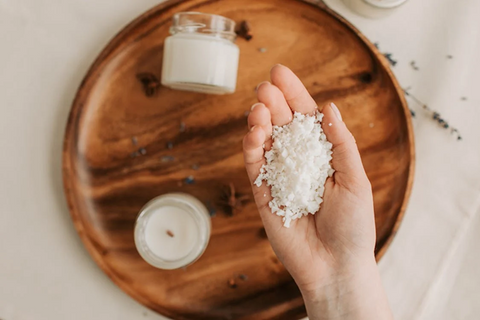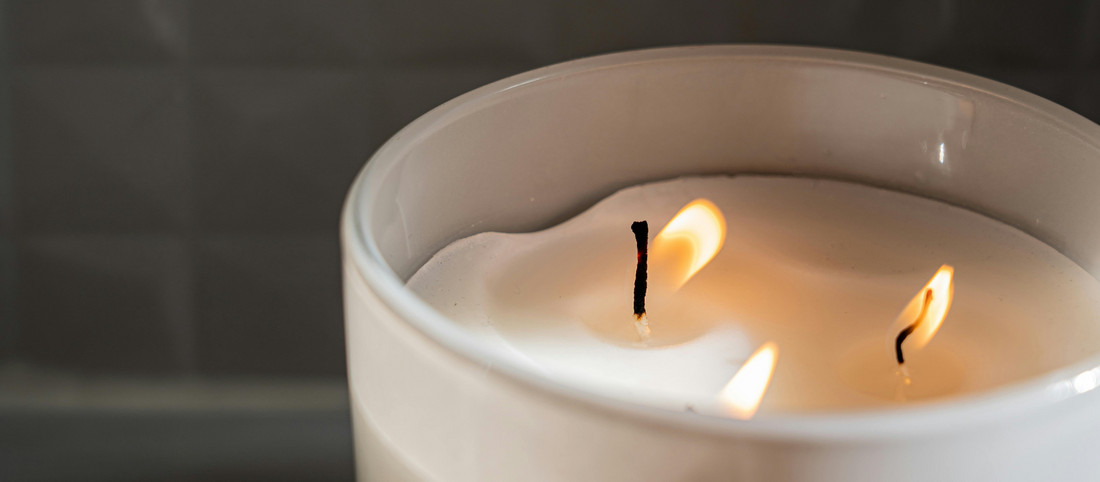
Ever watched a candle melt and wondered where all that wax goes? Does it just evaporate, or is there a fire risk lurking in its soothing glow?
It's time we get into the nitty-gritty of the ingredients that craft the candles we love, to not only satisfy our curiosity but to ensure we're creating and using products that are safe for everyone. We’ll answer those burning questions about candle wax's flammability, illuminating the facts, debunking any myths and guiding you through some of the essentials of candle safety.
Whether you're a hobbyist or a professional candle maker, knowing the ins and outs of your wax is key to keeping the flame of creativity burning safely.
Understanding candle wax characteristics
Getting to know your candle wax is like unpacking the DNA of your creations. It’s important for both safety and performance. Different waxes not only burn at varying rates but also influence the candle's overall burning experience, scent throw, and aesthetic appeal.
Let’s take a deeper look at some popular options:
Paraffin wax
Think of paraffin as the old soul of candle waxes. It's been around the block, offering a stellar scent throw and possessing the ability to hold colours well. But, it's a bit of a sprinter, burning faster than its natural counterparts, and can get a bit smoky if not handled right.
Average melting point: 46-68 °C
Soy wax
Derived from soybean oil, soy wax stands out for its renewable origins. It burns slightly slower and cleaner than paraffin, making candles last longer and reducing indoor air pollution. Soy wax's natural composition means it's biodegradable, but it might not hold fragrance and colour as strongly as paraffin.
Average melting point: 49-82 °C
Coconut/rapeseed wax blend
This blend is the best of both worlds, marrying the clean burn of coconut with the sturdy scent-carrying abilities of rapeseed wax. It's a slow-burner that keeps things smooth and even, perfect for those looking for a soot-free candle experience.
Average melting point: 40-46 °C
Each wax type brings its own strengths and weaknesses to the table, from burn time and scent throw to environmental impact. Knowing and comparing these properties allows you to tailor your creations to meet specific needs of your clientele, ensuring safety, efficiency and satisfaction in every flicker.
What happens to the wax when your candle burns?
When a candle is lit, a fascinating process unfolds. It’s not just the wick catching fire; the flame heats the wax around the wick, transforming it into a liquid. This melted wax then travels up the wick—a process known as capillary action—moving closer to the flame’s heat.
As it ascends, the wax is heated even more and it eventually evaporates. This now vaporised wax, not the solid wax or the wick itself, is what actually fuels the flame. While we assume that the wick is what’s burning, it’s actually just a vehicle for the process, channelling the melted wax upwards where it can vaporise and ignite.
The result? The steady glow we all know and love that can burn for hours, provided that the balance between wick and wax is maintained. This wax and wick tag team ensures that the candle burns efficiently, with minimal risk of flaring or uncontrolled burning.

Is candle wax flammable?
Now that you understand it's not just the wick that's ablaze, you might be wondering about the fire risk of the wax you're working with. Is candle wax flammable? The short answer is yes, but before you start fretting over the bulk candle wax you’ve got stored in your workshop, let us explain.
Candle wax, in its solid state, isn't something that'll easily catch fire on its own. It's the transformation of wax from solid to vapour, through the heat of the flame, that really gets the fire going. This evaporated wax is the actual fuel for the candle's flame, not the wick or the solid wax itself.
So, while the wax plays a crucial role in keeping the flame alive, it's the process of melting and vaporisation that's key to a controlled and safe burn.
The role of additives in wax safety
Quick recap: wax is flammable, but only when in gas form, which means that the flame is usually safe and controlled. You may have taken the choice of wax into consideration when considering the safety of your candle, but what about all of the ingredients you add afterwards? Think dyes, fragrances, decorations, etc.
Additives can transform a simple candle into a sensory delight, but they come with their own safety considerations. Dyes and fragrances, the most common additives, can alter the burning characteristics of wax, affecting everything from the burn rate to the flame size.
It's a tricky balance; too much fragrance oil, for example, can increase a candle's flammability, leading to a larger, potentially unsafe flame. Similarly, certain dyes can react with wax in unexpected ways, influencing how the candle burns. Understanding how different additives interact with your chosen wax is essential for creating candles that are not only beautiful and fragrant but also safe to use.
Top tip from NI Candle Supplies: Always adhere to recommended usage rates for additives and conduct thorough testing with each new recipe to ensure that your candles burn just as intended.
Wax safety tips for candle making and usage
Crafting and enjoying candles safely is a top priority for both makers and users. Keep in mind, while wax itself isn't highly flammable in solid form, its vapour is what fuels the flame. So, understanding how to manage this transformation from solid to vapour is essential for safe candle making and usage.
Here's how to keep things lit without any mishaps:
For makers
- Choose the right wax: Each wax type has its own burn characteristics. Understand the properties of your chosen wax—whether it's paraffin, soy or a blend—to ensure it suits your candle's intended use and design.
- Test your wicks: Not all wicks are created equal, especially when paired with different waxes. Conduct thorough testing with your chosen wax to find the wick that burns most efficiently and safely.
- Monitor the melt pool: Keep an eye on how your wax melts during the burn test. A properly sized wick will create an even melt pool without leaving excess wax on the sides.
- Consider additives carefully: Some additives can affect the burn quality of your wax. If you're using colourants or fragrance oils, make sure they're compatible with your wax and won't increase its flammability.
For users
-
First burn is crucial: Ensure your first burn lasts until the entire top layer of wax melts to the edge. This prevents tunnelling and promotes an even burn in future uses.
-
Trim the wick: Before each burn, trim the wick to about 1/4 inch. This keeps the flame controlled and reduces soot.
-
Avoid draughts: Burn your candle in a draught-free area to prevent uneven burning and possible flare-ups.
- Don't overdo it: Limit each burning session to a maximum of 4 hours to prevent excessive heat build-up in the container.
With these tips in hand for both makers and users, you're well-equipped to enjoy the warm glow of candles safely. Remember, knowledge and caution with your wax can light up your space while keeping hazards at bay.

Wax storage tips
Your wax stash isn't a ticking time bomb, but that doesn't mean you can just stash it anywhere. While not prone to spontaneous combustion, solid candle wax still needs some TLC when it comes to storage.
Keep it cool, keep it dry. High temperatures can mess with wax's texture and scent-holding abilities, especially for the more delicate soy and coconut waxes. And moisture? Not your friend here. It can lead to funky moulds or even affect how the wax melts and holds fragrance. So, think cool pantry, not hot garage.
Also, keep your waxes separated; you don't want your scented blends mingling with your unscented bases. A little organisation can prevent a lot of headache (and nose-aches) down the line. If you’ve already turned your wax into candles and melts, there is also specific storage advice you can follow to best preserve them.
Circling back to the main question: Is candle wax flammable?
Yes, but with a caveat. It's not the solid wax that poses a fire risk, but its vapour when heated by the candle's flame. Understanding this key aspect can significantly demystify safety concerns and empower both candle makers and users. Armed with knowledge about wax properties, melting points and safe handling practices, you can continue to craft and enjoy candles with confidence.
Whether you're a seasoned candle maker or just starting out, embracing these insights can elevate your craft and ensure every candle you create is not only beautiful but safe. The crafting process is filled with potential, and with the right precautions, you can light up lives without sparking concerns. So, keep the flame of creativity burning bright, but never forget the foundation of safety it stands on.
